Abstract
Three hundred and sixty-seven women presenting to the Breast Unit at Guy's Hospital between 1975 and 1990 whose first distant metastasis was in the skeleton were identified and the influence of a number of patient and tumour characteristics on the development and subsequent prognosis of bone metastases was assessed. One hundred and thirty-nine women had disease that remained clinically confined to the skeleton. They were more likely to be older, with lobular carcinoma and to have presented initially with little or no axillary lymph node involvement. The 228 women who subsequently developed disease at extra-osseus sites were more likely to have poorly differentiated ductal tumours and heavy lymph node involvement at primary diagnosis. On multivariate analysis, the clinical and pathological factors of greatest prognostic importance for survival after the development of bone metastases were histological grade (P = < 0.0001), oestrogen receptor status (P = < 0.0001), bone disease at initial presentation (P = < 0.0001), disease-free interval (P = 0.002) and age (P = 0.006).
Full text
PDF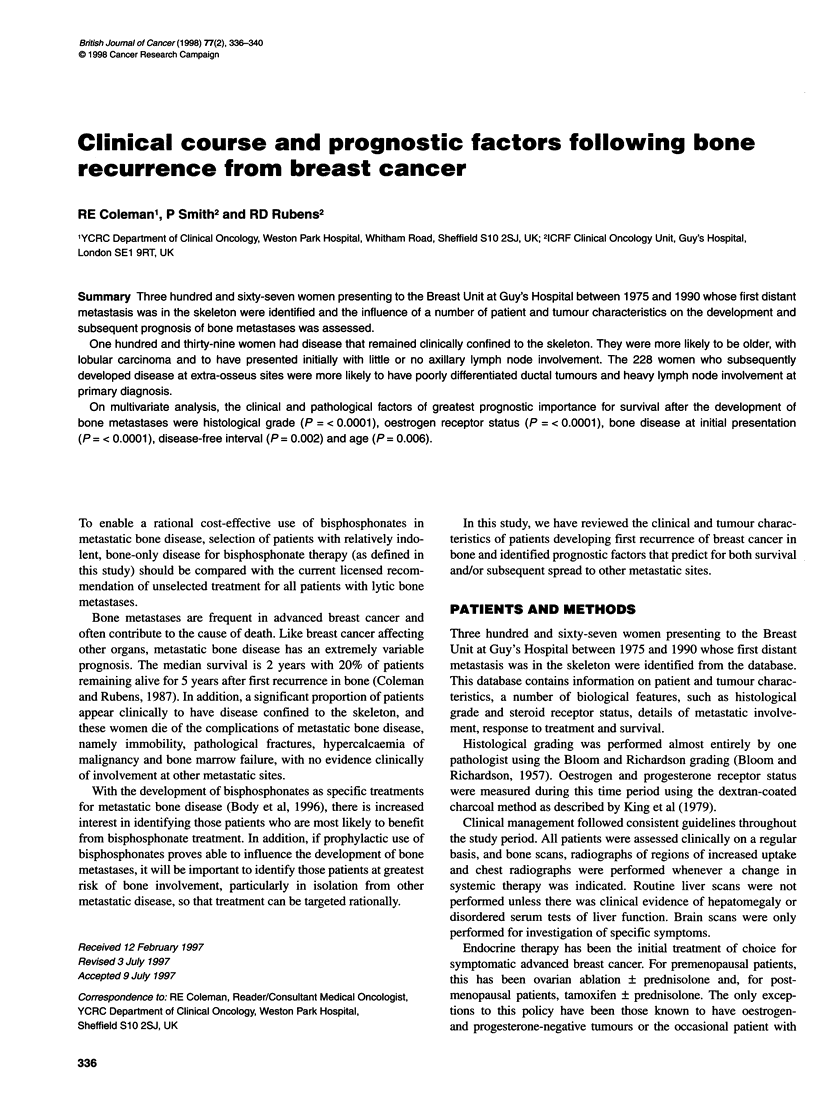
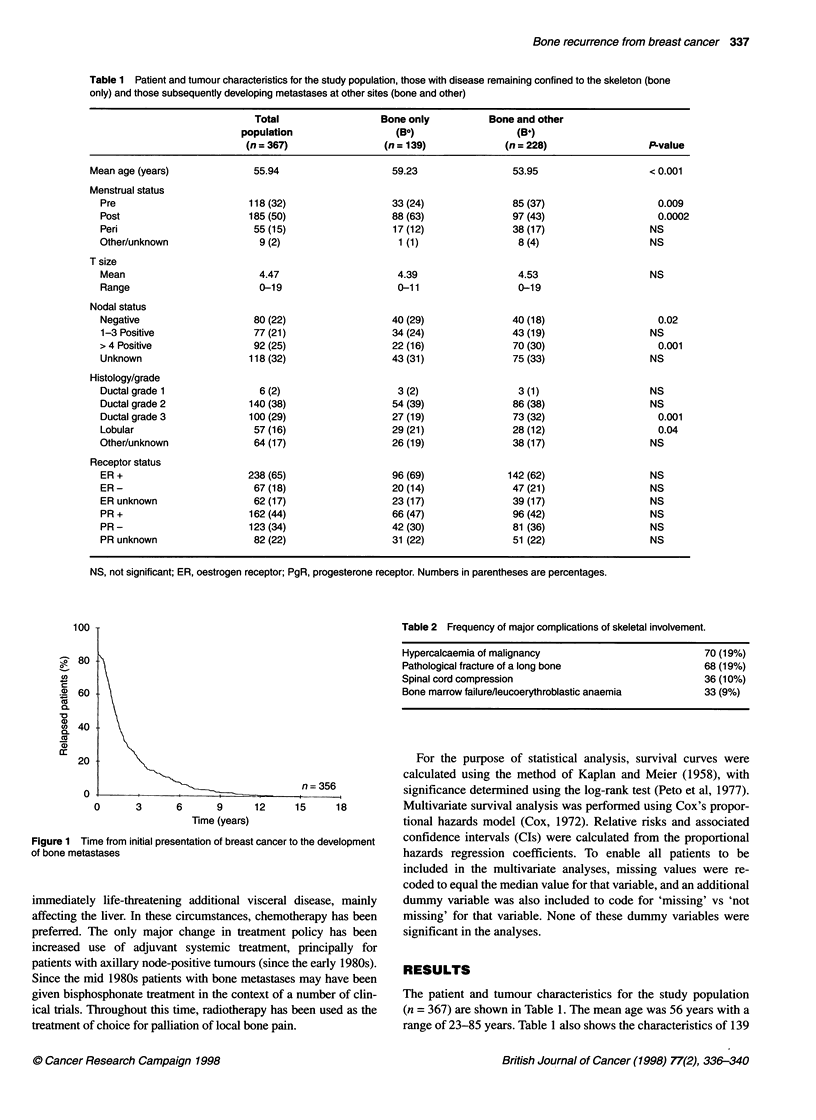
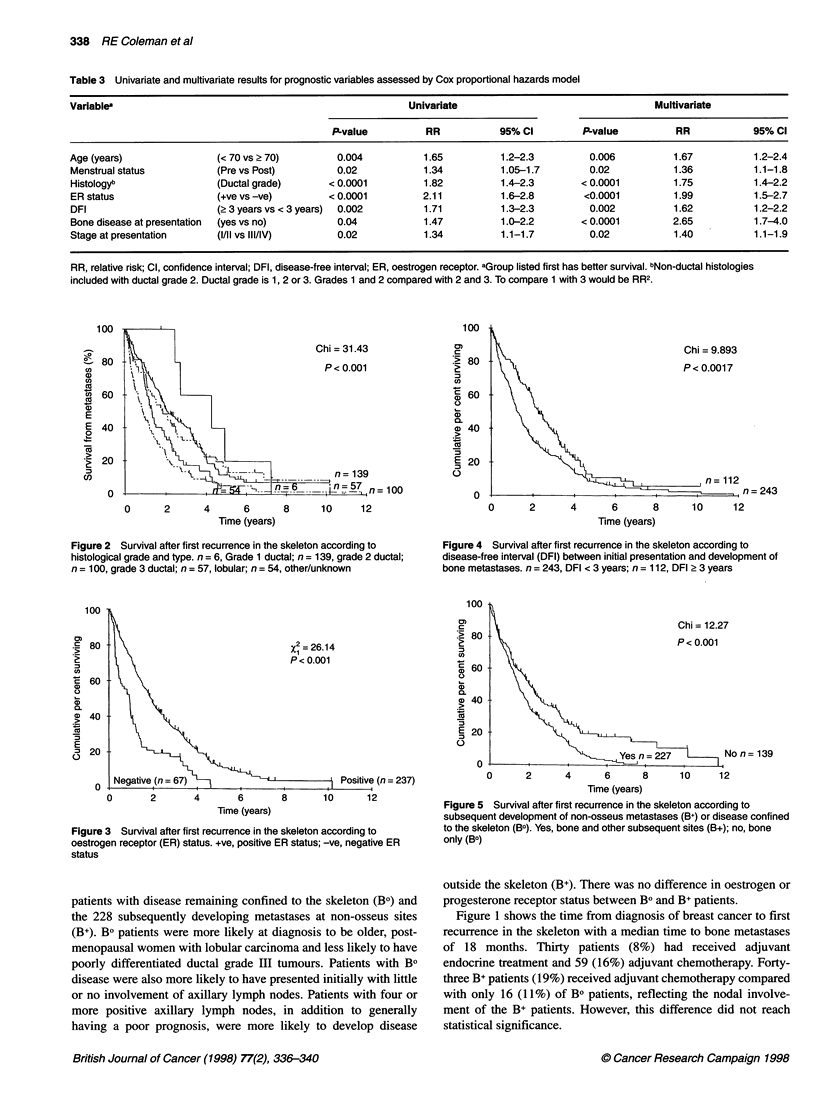
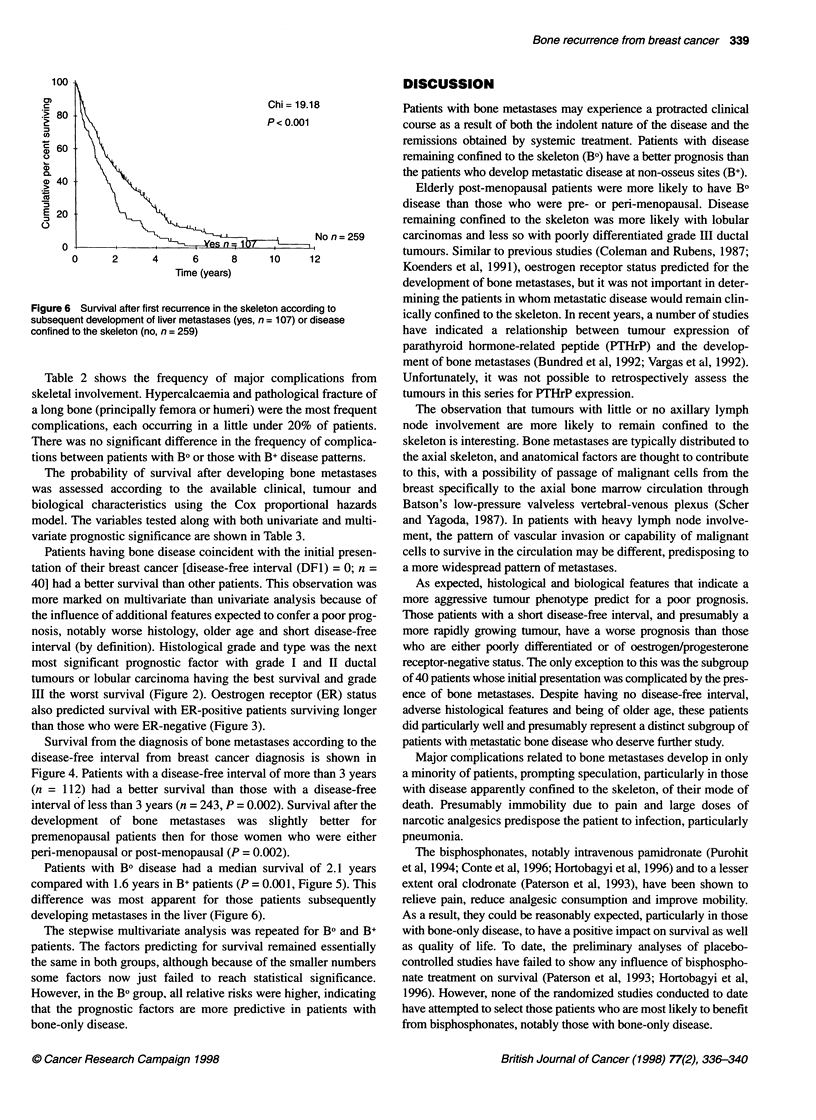
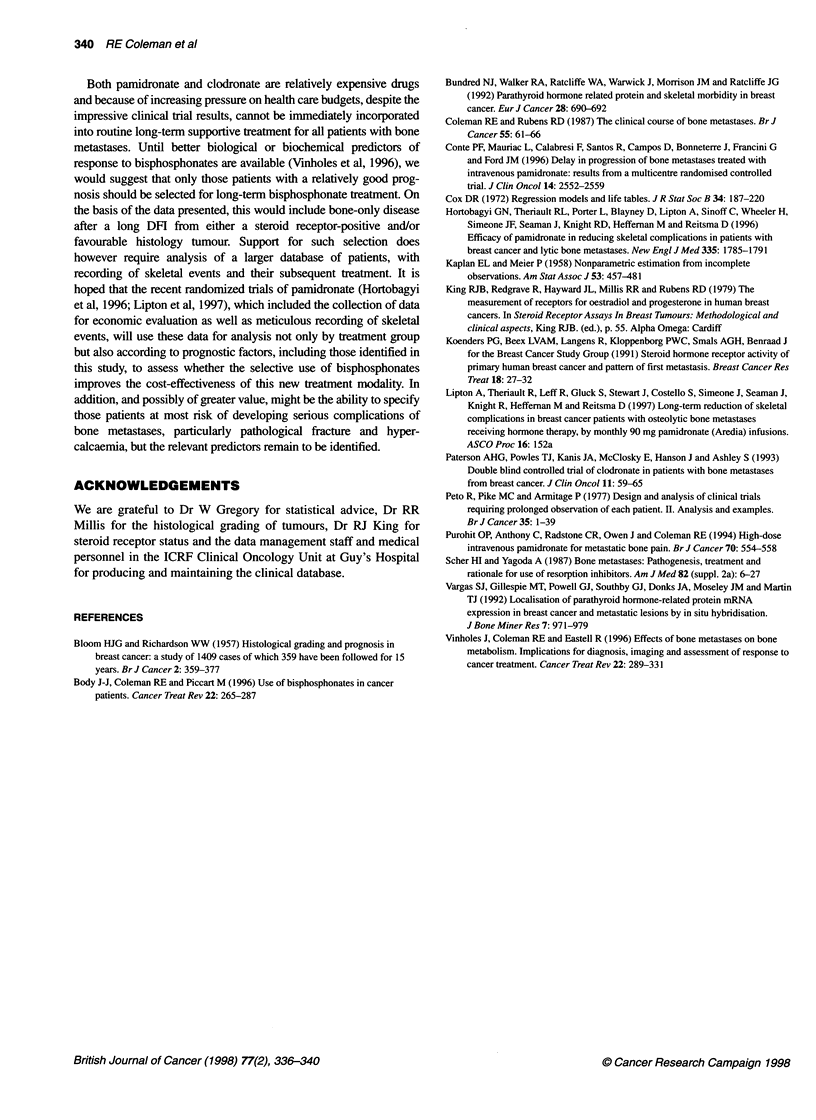
Selected References
These references are in PubMed. This may not be the complete list of references from this article.
- BLOOM H. J., RICHARDSON W. W. Histological grading and prognosis in breast cancer; a study of 1409 cases of which 359 have been followed for 15 years. Br J Cancer. 1957 Sep;11(3):359–377. doi: 10.1038/bjc.1957.43. [DOI] [PMC free article] [PubMed] [Google Scholar]
- Body J. J., Coleman R. E., Piccart M. Use of bisphosphonates in cancer patients. Cancer Treat Rev. 1996 Jul;22(4):265–287. doi: 10.1016/s0305-7372(96)90020-1. [DOI] [PubMed] [Google Scholar]
- Bundred N. J., Walker R. A., Ratcliffe W. A., Warwick J., Morrison J. M., Ratcliffe J. G. Parathyroid hormone related protein and skeletal morbidity in breast cancer. Eur J Cancer. 1992;28(2-3):690–692. doi: 10.1016/s0959-8049(05)80127-3. [DOI] [PubMed] [Google Scholar]
- Coleman R. E., Rubens R. D. The clinical course of bone metastases from breast cancer. Br J Cancer. 1987 Jan;55(1):61–66. doi: 10.1038/bjc.1987.13. [DOI] [PMC free article] [PubMed] [Google Scholar]
- Conte P. F., Latreille J., Mauriac L., Calabresi F., Santos R., Campos D., Bonneterre J., Francini G., Ford J. M. Delay in progression of bone metastases in breast cancer patients treated with intravenous pamidronate: results from a multinational randomized controlled trial. The Aredia Multinational Cooperative Group. J Clin Oncol. 1996 Sep;14(9):2552–2559. doi: 10.1200/JCO.1996.14.9.2552. [DOI] [PubMed] [Google Scholar]
- Hortobagyi G. N., Theriault R. L., Porter L., Blayney D., Lipton A., Sinoff C., Wheeler H., Simeone J. F., Seaman J., Knight R. D. Efficacy of pamidronate in reducing skeletal complications in patients with breast cancer and lytic bone metastases. Protocol 19 Aredia Breast Cancer Study Group. N Engl J Med. 1996 Dec 12;335(24):1785–1791. doi: 10.1056/NEJM199612123352401. [DOI] [PubMed] [Google Scholar]
- Koenders P. G., Beex L. V., Langens R., Kloppenborg P. W., Smals A. G., Benraad T. J. Steroid hormone receptor activity of primary human breast cancer and pattern of first metastasis. The Breast Cancer Study Group. Breast Cancer Res Treat. 1991 Mar;18(1):27–32. doi: 10.1007/BF01975440. [DOI] [PubMed] [Google Scholar]
- Paterson A. H., Powles T. J., Kanis J. A., McCloskey E., Hanson J., Ashley S. Double-blind controlled trial of oral clodronate in patients with bone metastases from breast cancer. J Clin Oncol. 1993 Jan;11(1):59–65. doi: 10.1200/JCO.1993.11.1.59. [DOI] [PubMed] [Google Scholar]
- Peto R., Pike M. C., Armitage P., Breslow N. E., Cox D. R., Howard S. V., Mantel N., McPherson K., Peto J., Smith P. G. Design and analysis of randomized clinical trials requiring prolonged observation of each patient. II. analysis and examples. Br J Cancer. 1977 Jan;35(1):1–39. doi: 10.1038/bjc.1977.1. [DOI] [PMC free article] [PubMed] [Google Scholar]
- Purohit O. P., Anthony C., Radstone C. R., Owen J., Coleman R. E. High-dose intravenous pamidronate for metastatic bone pain. Br J Cancer. 1994 Sep;70(3):554–558. doi: 10.1038/bjc.1994.344. [DOI] [PMC free article] [PubMed] [Google Scholar]
- Scher H. I., Yagoda A. Bone metastases: pathogenesis, treatment, and rationale for use of resorption inhibitors. Am J Med. 1987 Feb 23;82(2A):6–28. doi: 10.1016/0002-9343(87)90483-9. [DOI] [PubMed] [Google Scholar]
- Vargas S. J., Gillespie M. T., Powell G. J., Southby J., Danks J. A., Moseley J. M., Martin T. J. Localization of parathyroid hormone-related protein mRNA expression in breast cancer and metastatic lesions by in situ hybridization. J Bone Miner Res. 1992 Aug;7(8):971–979. doi: 10.1002/jbmr.5650070814. [DOI] [PubMed] [Google Scholar]
- Vinholes J., Coleman R., Eastell R. Effects of bone metastases on bone metabolism: implications for diagnosis, imaging and assessment of response to cancer treatment. Cancer Treat Rev. 1996 Jul;22(4):289–331. doi: 10.1016/s0305-7372(96)90021-3. [DOI] [PubMed] [Google Scholar]


